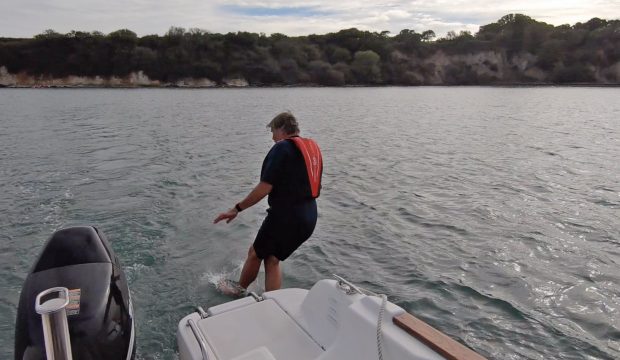Lifecord, a new alarmed smart kill cord that knows when you are not wearing it, ensures you’ll never forget to clip on again
We’ve all done it and we all promise we’ll never let it happen again, yet whatever steps we take, it keeps on reoccurring. We’re talking about forgetting to clip on your kill cord, that innocuous little red line that can literally make the difference between life and death.
Anybody who’s ever driven a sportsboat or an outboard-powered tender will know exactly what we’re referring to; in theory you should always keep the kill cord permanently wrapped around your leg or clipped to your lifejacket, even if that means cutting the engine when you leave the helm.
However, in reality, many of us choose to start the engine first before we clip on, or leave the engine running in neutral and unclip from the cord when we need to adjust a line or fender; the danger is that you forget to clip back on again when you return to the helm.

The Lifecord will fit any new or existing boat already fitted with a kill switch
Now Motor Boat & Yachting has helped develop a brand new ‘smart’ kill cord that ensures you need never forget again.
The Lifecord is a direct replacement for your boat or tender’s existing kill cord and operates the boat’s kill switch in exactly the same way; however, it also features a sophisticated built-in alarm than senses when you’re wearing it and reminds you when you’re not, much like the seatbelt alarm in a car.
It won’t trigger immediately – giving you time to start the engine or adjust a line – and features a number of other refinements to ensure it’s much better suited to life at sea.
Built to last
The whole unit is self-contained with its own battery so that it doesn’t need to plug into the boat’s electrical circuit.
No power is drawn until the clip head is attached to the kill switch, and the battery has sufficient power to sound the alarm continuously for 50 hours, so it should last for many seasons before needing replacing. Even then, a low-battery light alerts you that it needs changing — a DIY job that takes seconds to do.

A magnetic sensor recognises when the cord is pulled taut around the user’s leg or clipped to the lifejacket key and disables the alarm. A manual catch ensures the key can’t slip out accidentally
The Lifecord is waterproofed to IP67 and every part of it has been designed to be robust enough to withstand being thrown into grab bags or lockers.
It’s not just the construction that’s designed specifically for life at sea; instead of a simple audible alarm, the Lifecord has a sequence of warning tones that starts relatively quietly and gradually builds in volume at ten-second intervals to ensure it doesn’t irritate you or your guests if you do need to be away from the helm for more than the initial delay period.
After reaching its maximum volume (designed to be heard even over the roar of a powerful engine) it then starts the sequence again until you do remember to clip on. A bright LED warning light on the battery enclosure also flashes red as a visual reminder for the helmsperson and the crew.
The really clever bit is the sensor that attaches round your leg or on to your lifejacket. Instead of a tiny steel clip that can be awkward to use, particularly on colder days, Lifecord has a robust but compact clasp and key that is easy to attach and undo, even when wearing gloves.

The standard key is permanently attached to the cord and slots into the clasp once it has been pulled around the user’s leg. A separate second key is designed for clipping onto a lifejacket or clothing
Moulded into each part are opposing magnets that repel each other when not pulled tight so that it knows when the cord is stretched taut around your leg or simply looped on to itself.
For those who prefer to attach their kill cords to a lifejacket or item of clothing, a second ‘lifejacket’ key on a trap-gated carabiner clip is supplied that doesn’t need to be kept under tension to switch off the alarm.

A magnetic sensor recognises when the cord is pulled taut around the user’s leg or clipped to the lifejacket key and disables the alarm. A manual catch ensures the key can’t slip out accidentally
One size fits all
A system of detachable clip heads supplied with every Lifecord ensures that the vessel switch can quickly and easily be adapted to fit all common types of engine and kill switch, both old and new, including Mercury, Honda, Suzuki, Yamaha, Evinrude, Tohatsu, Mariner and more. Even if you change your boat or engine, you can simply remove the old clip head and attach a new one.

A plunger switch activates the unit as soon as it’s attached to the kill switch. It beeps once to signal it’s working. Removable clip heads adapt it to fit any make of boat or outboard engine
Lifecord is built in the UK to exacting standards and has been designed to pass the Lloyd’s Classification process. It has also been granted a number of multinational patents to protect its many innovations.
Motor Boat & Yachting has been closely involved in the development of Lifecord from the outset, having inspired its inventor John Barker to come up with a solution to the problem of kill cord-related deaths and injuries (see MBY February 2018 for the full story). We are now working with him to ensure its rapid adoption by boat owners and the industry.
To be one of the first to own this game-changing device, buy your Lifecord now for just £89.95 on the Landau UK website.











